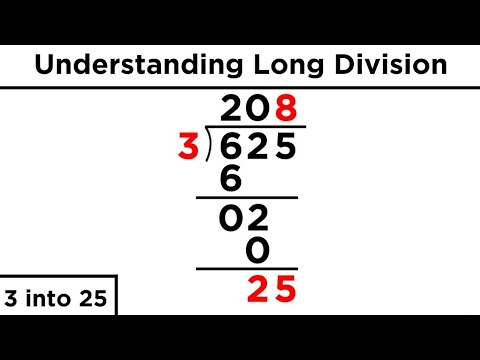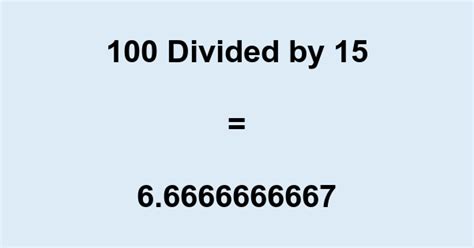The Exact Answer to 100/15

Let's delve into the intriguing world of mathematics and explore the result of dividing 100 by 15. While this may seem like a simple arithmetic operation, it opens up a range of fascinating insights and applications, especially when we consider its real-world implications and the mathematical concepts it encompasses.
Understanding the Division of 100 by 15

The division of 100 by 15 is a fundamental mathematical operation that yields a quotient and a remainder. When we perform this division, we aim to find out how many times 15 can fit into 100, with any remaining value indicating the remainder. This concept is essential in various mathematical and real-life scenarios, from basic arithmetic to more complex problem-solving.
Mathematically, we can represent the division as:
100 ÷ 15 = Quotient R Remainder
Where Quotient is the number of times 15 goes into 100, and Remainder is the value left over.
In this case, the calculation reveals that 15 goes into 100 a total of 6 times, with a remainder of 10. This can be expressed as:
100 ÷ 15 = 6 R 10
This result has various applications and interpretations, which we'll explore further.
The Quotient: 6
The quotient of 6 indicates that if we were to repeatedly subtract 15 from 100, we would do so 6 times before reaching zero. This concept is fundamental in arithmetic and forms the basis for more advanced mathematical operations.
For example, if we were distributing 100 items into groups of 15, we would create 6 groups, and have 10 items left over.
In terms of percentages, the quotient of 6 means that 15% of 100 is equal to 15, and we can express this as a fraction: 15/100 or as a decimal: 0.15.
The Remainder: 10
The remainder of 10 is the value that is left over after dividing 100 by 15. It represents the part of 100 that is not divisible by 15. This concept is crucial in understanding the limitations of whole-number division and the need for more advanced mathematical techniques.
In our example, the remainder of 10 means that we cannot divide 100 exactly by 15. This has implications in various real-world scenarios, such as when dividing resources or quantities that are not divisible by the divisor.
Real-World Applications and Interpretations

The division of 100 by 15 has numerous applications and interpretations in various fields. Let's explore some of these real-world scenarios and their implications.
Distribution and Resource Allocation
Imagine a scenario where you have 100 items and you need to distribute them evenly among 15 people. The division of 100 by 15 would help you determine the number of items each person would receive (6 items) and the number of items left over (10 items). This application is crucial in resource allocation and distribution problems.
For instance, if you were dividing 100 dollars among 15 friends, each friend would receive $6, with $10 left over.
Percentage and Fraction Calculations
The quotient and remainder of 100 divided by 15 can also be interpreted as percentages and fractions. The quotient of 6 means that 15% of 100 is equal to 15, and we can express this as the fraction 15/100 or as a decimal 0.15. This interpretation is useful in various mathematical and statistical applications.
For example, if we were calculating the percentage of a survey result, the division of 100 by 15 could help us determine the proportion of respondents who chose a particular answer.
Limiting Factors and Constraints
The remainder of 10 in the division of 100 by 15 highlights the limitations of whole-number division. In real-world scenarios, this can represent constraints or limiting factors. For instance, if we were dividing 100 tasks among 15 people, the remainder of 10 would indicate that not all tasks could be evenly distributed, and some people would have to take on more tasks.
Advanced Mathematical Concepts
The division of 100 by 15 can also introduce more advanced mathematical concepts and techniques. These concepts are essential for understanding more complex mathematical problems and applications.
Fractional and Decimal Representations
The quotient of 6 and the remainder of 10 can be expressed as fractions and decimals. The fraction 6 10/15 represents the division of 100 by 15, where the numerator (6) is the quotient, and the denominator (15) is the divisor. This fraction can also be simplified to 2 2/3.
The decimal representation, 6.66..., shows the recurring nature of the division, as 15 goes into 100 an infinite number of times, with a recurring remainder of 10.
Modular Arithmetic and Clock Arithmetic
The division of 100 by 15 can also be understood in the context of modular arithmetic, where the remainder plays a significant role. In modular arithmetic, the result of a division is the remainder, and this has applications in various fields, including computer science and cryptography.
For instance, in clock arithmetic, where the numbers "wrap around" at 12, the division of 100 by 15 would result in a remainder of 10, indicating that we have "passed" the 12 o'clock mark by 10 hours.
Educational and Learning Implications
The division of 100 by 15 is an excellent example to illustrate various mathematical concepts and operations to students. It can help them understand the fundamentals of division, remainders, percentages, and fractions, as well as introduce more advanced concepts like modular arithmetic.
Teachers can use this example to create engaging and interactive lessons, helping students grasp mathematical concepts in a practical and relatable way. By understanding the division of 100 by 15, students can build a strong foundation for more complex mathematical operations and problem-solving skills.
Conclusion: The Significance of 100/15

The division of 100 by 15 is a simple yet powerful mathematical operation with numerous applications and interpretations. It showcases the fundamentals of division, the concept of remainders, and the importance of understanding mathematical concepts in real-world scenarios.
From distribution and resource allocation to percentage and fraction calculations, the result of 100/15 has a wide range of implications. It also introduces more advanced mathematical concepts like modular arithmetic, which have applications in various fields.
Understanding the division of 100 by 15 is not only an essential part of mathematical education but also a valuable tool for problem-solving and critical thinking. It demonstrates the beauty and practicality of mathematics, and its relevance in our daily lives.
So, the next time you encounter the division of 100 by 15, remember the rich mathematical journey it takes you on, and the many insights and applications it offers.
What is the significance of the remainder in division?
+The remainder in division represents the value that is left over after the division process. It is important because it highlights the limitations of whole-number division and the need for more advanced mathematical techniques. In real-world scenarios, the remainder can represent constraints or limiting factors.
How can we interpret the quotient and remainder in practical terms?
+The quotient represents the number of times the divisor goes into the dividend, while the remainder is the value left over. In practical terms, the quotient can be used for distribution and resource allocation, while the remainder can indicate limitations or constraints.
What are some real-world examples where the division of 100 by 15 is applicable?
+The division of 100 by 15 can be applicable in scenarios like dividing 100 items among 15 people, calculating percentages in surveys, or understanding modular arithmetic in computer science and cryptography. It has a wide range of real-world implications and applications.
Related Terms:
- 100 divided by 15
- 100 divided by 16
- 100 divided by 15 decimal
- 1000 divided by 15
- 100 divided by 5


